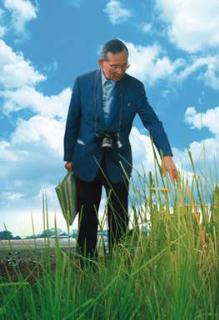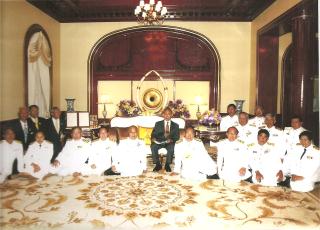
The King of Thailand
and the Miracle Vetiver Grass
Royal Initiatives Concerning Vetiver Grass

The person behind the success of vetiver technology in Thailand is His Majesty King Bhumibol Adulyadej, the first person in the country to recognize the potential value of vetiver for soil and water conservation. His Majesty advocated the idea that studies and experiments should be conducted on vetiver grass, initially to Dr. Sumet Tantivejkul, Secretary-General of the Royal Development Projects Board on 22 June 1991, and later to concerned parties on various occasions, particularly when he visited the sites of the Royal Development Study Centres and the Royal Development Projects.

"…the cultivation of the vetiver grass should be experimented at the Huai Sai and Khao Hin Sorn Royal Development Study Centres as well as in other areas to prevent soil erosion. The cultivation should be suitable and the data on the studies and experimentations covering all aspects should be collected…"
His Majesty's remark
Given at Chitralada Villa,
Dusit Palace, Bangkok
on 22 June 1991
Through his own initiatives and supported numerous experiments conducted by various Royal Development Study Centres as well as several cooperating agencies, vetiver has come a long way from an obscure plant to become one of the most popular plants in Thailand in just a few years. Vetiver was, and still is, referred to as "miracle grass".
On 31 August 2009, His Majesty gave the speech to the Privy Councilor and the representatives of the agencies involved in the Development and Promotion of the Utilization of Vetiver Grass Project According to the Royal Initiative at Klai Kangwol Palace, Prachuap Khiri Khan Province which are summarized as follow:

"The study on vetiver grass has been done for about 17 years now. Although it has been a long time, the grass has created a number of benefits which are highly effective. It is such a miracle that this kind of grass can produce benefits for different area conditions may it be the plains or the mountains, shallow soil or deep soil. For the deep soil, it appears that the root of this grass can go down up to 5 to 6 metres and does not spread to the sides which means that it is not dangerous to the root system of the plants that are useful.
The beginning of this grass was when I had an audience with HRH the Princess Mother. At that time, she was not well. She felt a little depressed with the illness. I then said to her that I needed her help to bring benefits of one kind of grass to show to the entire nation. She suddenly became active. She thought that everything had already been studied. I said that this was the thing that had not yet been studied or had been studied very little. I thus narrated to her about the miracle of vetiver grass which is just an ordinary plant but with attributes that can bring up benefits of other plants. I have never imagined that such an ordinary grass can help promote productive farming.
Her Royal Highness asked where to do. I said at the same place where she used to do her project and a part of which was the mountains. I meant the place which she liked a lot and that was Doi Tung. I said that if this grass was not used there, the conditions of the land would not be good. She was not sure how the grass could make things good. Normally, wherever a kind of grass covers, the land would turn unproductive. However, for the vetiver grass, if we choose the right ecotype and grow in a proper pattern, the grass will flourish amazingly and it can help turn the land productive and useful. Then I told her about the methods of planting and selecting the ecotypes.
Instantly, the Princess Mother became excited and asked if she could be of any help. I said that she could do it right away if she was ready. She thus called in her staff and told them that she would start a project. Miracle as it is, the grass could truly light up her spirits. Only a few days after that, she went to Doi Tung and asked her staff to collect different ecotypes of vetiver grass. I suggested her to grow in different sites to experiment on them. Despite her poor health and resistance from doctors, she insisted to go out in the fields. She walked and planted the vetiver grass herself. Within a few days, the grass grew in good shape.
The roots of this grass can go deep down in the soil. Some ecotypes can push down the roots as deep as four, five or even six metres while other may be only at three metres. This helps protect the soil from eroding and build up the strength of the soil making it usable as needed. For example, along the roadsides up to Doi Tung, the soil was bound together tightly and the plants grown were kept in their place. The roads were safe and strong because of the vetiver grass. Therefore, the vetiver grass enabled us to safely plant trees along the roadsides and to prevent erosion which would otherwise cause damages to agriculture."
Thailand and Vetiver Grass
International Recognition
His Majesty's role in using vetiver for soil and water conservation and his contributions for the promotion of the utilization of vetiver grass internationally, for examples, supporting fund for the organization of the International Conferences on Vetiver (ICVs) and granting the King of Thailand Vetiver Awards for the outstanding vetiver researches and dissemination works, has been recognized.
On 25 February 1993, the International Erosion Control Association (IECA) presented the International Merit Award to His Majesty for assuming the exemplary role in the utilization of vetiver for soil and water conservation.

On 30 October 1993, the World Bank presented His Majesty with a specially-commissioned bronze sculpture of a vetiver plant together with a certificate as the Award of Recognition "for technical and development accomplishment in the promotion of the vetiver technology internationally".

To read more of His Majesty's remarks on vetiver in other occasions, click here to download
"The Royal Messages Concerning Vetiver: A Miracle Grass"










